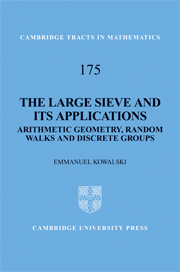Book contents
- Frontmatter
- Contents
- Preface
- Acknowledgments
- Prerequisites and notation
- 1 Introduction
- 2 The principle of the large sieve
- 3 Group and conjugacy sieves
- 4 Elementary and classical examples
- 5 Degrees of representations of finite groups
- 6 Probabilistic sieves
- 7 Sieving in discrete groups
- 8 Sieving for Frobenius over finite fields
- Appendix A Small sieves
- Appendix B Local density computations over finite fields
- Appendix C Representation theory
- Appendix D Property (T) and Property (τ)
- Appendix E Linear algebraic groups
- Appendix F Probability theory and random walks
- Appendix G Sums of multiplicative functions
- Appendix H Topology
- References
- Index
2 - The principle of the large sieve
Published online by Cambridge University Press: 05 October 2009
- Frontmatter
- Contents
- Preface
- Acknowledgments
- Prerequisites and notation
- 1 Introduction
- 2 The principle of the large sieve
- 3 Group and conjugacy sieves
- 4 Elementary and classical examples
- 5 Degrees of representations of finite groups
- 6 Probabilistic sieves
- 7 Sieving in discrete groups
- 8 Sieving for Frobenius over finite fields
- Appendix A Small sieves
- Appendix B Local density computations over finite fields
- Appendix C Representation theory
- Appendix D Property (T) and Property (τ)
- Appendix E Linear algebraic groups
- Appendix F Probability theory and random walks
- Appendix G Sums of multiplicative functions
- Appendix H Topology
- References
- Index
Summary
Notation and terminology
We will start by describing a very general type of sieve. The goal is to reach an analogue of the large sieve inequality, in the sense of a reduction of a sieve bound to a bilinear form estimate.
We start by introducing the notation and terminology. Many readers, especially analytic number theorists, may find it excessively formal, but the framework we describe has so many different incarnations that it seems preferable to be very precise in this book, and to give a name to the objects involved to refer to them later on. Concrete applications will be able to eschew reproducing all this, by using self-contained statements such as those included in Section 3.5, which involve none of the newfangled terminology.
Hence, let's start. First of all, the sieve setting is a triple Ψ = (Y, ∧, (ρℓ)) consisting of
a set Y;
an index set ∧;
for all ℓ ∈ ∧, a surjective map ρℓ : Y → Yℓ where Yℓ is a finite set.
In combinatorial terms, this might be thought of as a family of colourings of the set Y. In applications, ∧ will often be a subset of primes (or prime ideals in some number field), but as first pointed out by Zywina, this is not necessary for the formal part of setting up the sieve, and although the generality is not really abstractly greater, it is convenient to allow arbitrary ∧.
- Type
- Chapter
- Information
- The Large Sieve and its ApplicationsArithmetic Geometry, Random Walks and Discrete Groups, pp. 8 - 31Publisher: Cambridge University PressPrint publication year: 2008



